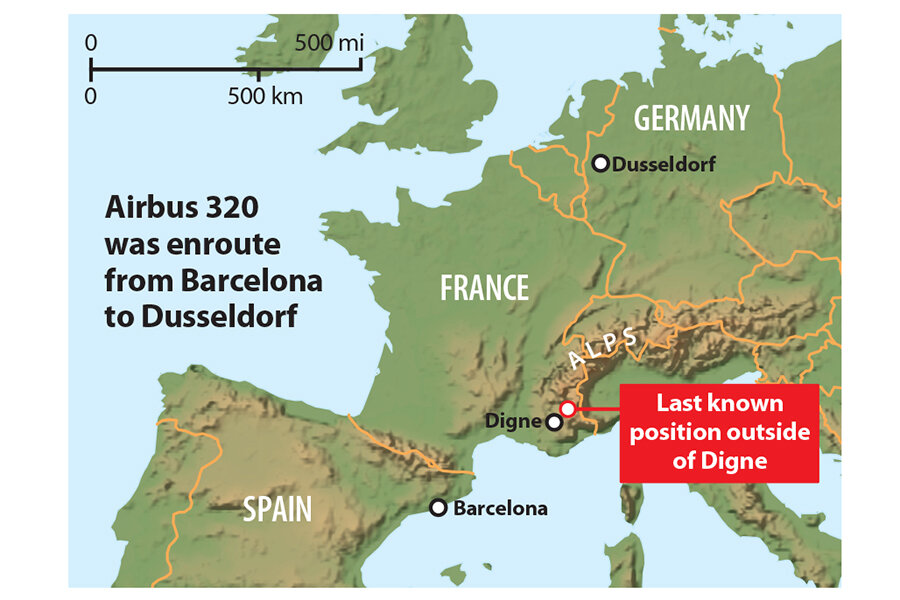Germanwings crash: What we know so far about Flight 4U 9525
Loading...
A Germanwings Airbus A320 plane carrying 144 passengers and six crew crashed Tuesday in the southeastern French Alps.
Initial media reports about Flight 4U9525, which was traveling from Barcelona, Spain, to Düsseldorf, Germany, indicated that the pilots sent a distress call to air traffic control in Marseilles. But French authorities now say this wasn’t the case, and that it was the controllers who sent out the distress signal after they lost contact with the aircraft.
The plane went down in mountainous terrain near Digne-les-Bains, in the Alpes de Haute Provence region, and CNN reported, that all passengers are dead. French police confirmed there are no survivors.
Photos of the crash site show small debris fragments scattered over a wide area, indicating the aircraft completely disintegrated when it hit the mountain.
"We saw an aircraft that had literally been ripped apart ... there is not one intact piece of wing or fuselage," Bruce Robin, prosecutor for the city of Marseille, told Reuters in Seyne-les-Alpes after flying over the crash zone in a helicopter.
The cause of the crash is unknown, and won't likely be officially known for months. But currently known flight details raise many questions: Why a descent one minute after reaching cruising altitude of 38,000 feet? Why no request to the air traffic control for a change in altitude? Why no mayday call from the pilots? Why no apparent change in airspeed or flight path before impacting the mountain?
In aviation forums, some have speculated that the pilots might have been incapacitated. Others speculated that faulty readings from instruments might have misled pilots about their errant flight path. Or, if the aircraft had a sudden problem at cruising altitude, the pilots might have been too busy trying to regain control of the aircraft to send out a distress call.
At this point, there is too little known about this crash to question the reliability of the Airbus 320. Airbus released information about this aircraft's history, and Lufthansa officials said that regular maintenance had been performed on the aircraft just one day before the crash. Some media reports have noted that the AirAsia flight that went down in the Java Sea between Indonesia and Singapore in December was also an Airbus A320-216.
Yet Airbus jets are on average no more or less safe than aircraft built by Boeing – and together, the two brands make up the majority of commercial passenger planes in the sky today. In fact, flying on a large commercial airliner is one of the safest ways to travel, with crash-related deaths in the last decade dropping to some of the lowest in aviation history.
The Airbus A320, first built in the late 1980s, has a reputation of being a “workhorse of the skies,” is flown by all major airlines in the United States, and has an excellent safety record, according to NBC.
SOAR, a group dedicated to helping people get over their fear of flying, placed the A320 among their top 10 safest passenger planes, noting that the aircraft has a record of 14 million flying hours per accident.
"It's a delight to fly," John Cox, a former pilot and the CEO of Safety Operating Systems, an aviation consulting company, told NBC. "It's a highly reliable airplane."
The model has been involved in a number of widely-covered incidents in the last few years, of which the downed AirAsia Flight 8501 was the latest. An A320 was also what Chesley Sullenberger guided into the Hudson River in 2009, after the plane struck a flight of birds and lost engine power.
The particular plane that crashed Tuesday has been in service for 24 years, and has logged more than 56,000 flight hours in 48,000 flights, according to Airbus and Germanwings. The crash is the first for Lufthansa subsidiary Germanwings, which was founded in 2012, according to The International Business Times.
Overall numbers for fatal plane crashes are at their lowest in decades.
For the average American, the annual risk of dying in a plane crash is about one in 11 million – far lower than the odds of dying in a car crash, which is about one in 5,000, David Ropeik, a risk communication instructor at Harvard University, found in 2006.
In terms of global commercial accidents, 2013 was the best year in the last five, recording 210 deaths in 16 fatal accidents, according to the latest figures by the International Air Transport Association, or IATA, which tracks airline safety statistics, among other figures.
And though 2014 didn’t fare as well, with 641 deaths in 12 fatal crashes – not including the 298 people killed in the Malaysia Airlines flight that was shot down over Ukraine – “the chances of being in a fatal aircraft accident are extremely rare,” Rudy Quevedo, global program director of Washington's Flight Safety Foundation, told CNN.
Still, because plane crashes tend result in sudden tragedy on a large scale, they tend to grab the public’s attention.
“People are... more sensitive about risks that are catastrophic, which kill people all at once in one place,” Harvard’s Mr. Ropeik wrote.
Initial reports say the passengers included 45 Spanish and 67 German nationals, according to The Guardian.
German chancellor Angela Merkel has said that Germany, Spain, and France are now in “deep mourning” over the tragedy, while Spanish prime minister Mariano Rajoy told reporters: "We’re facing a dramatic and very sad accident. We’re going to do everything in our power to help, to help the families and give them our support.”







